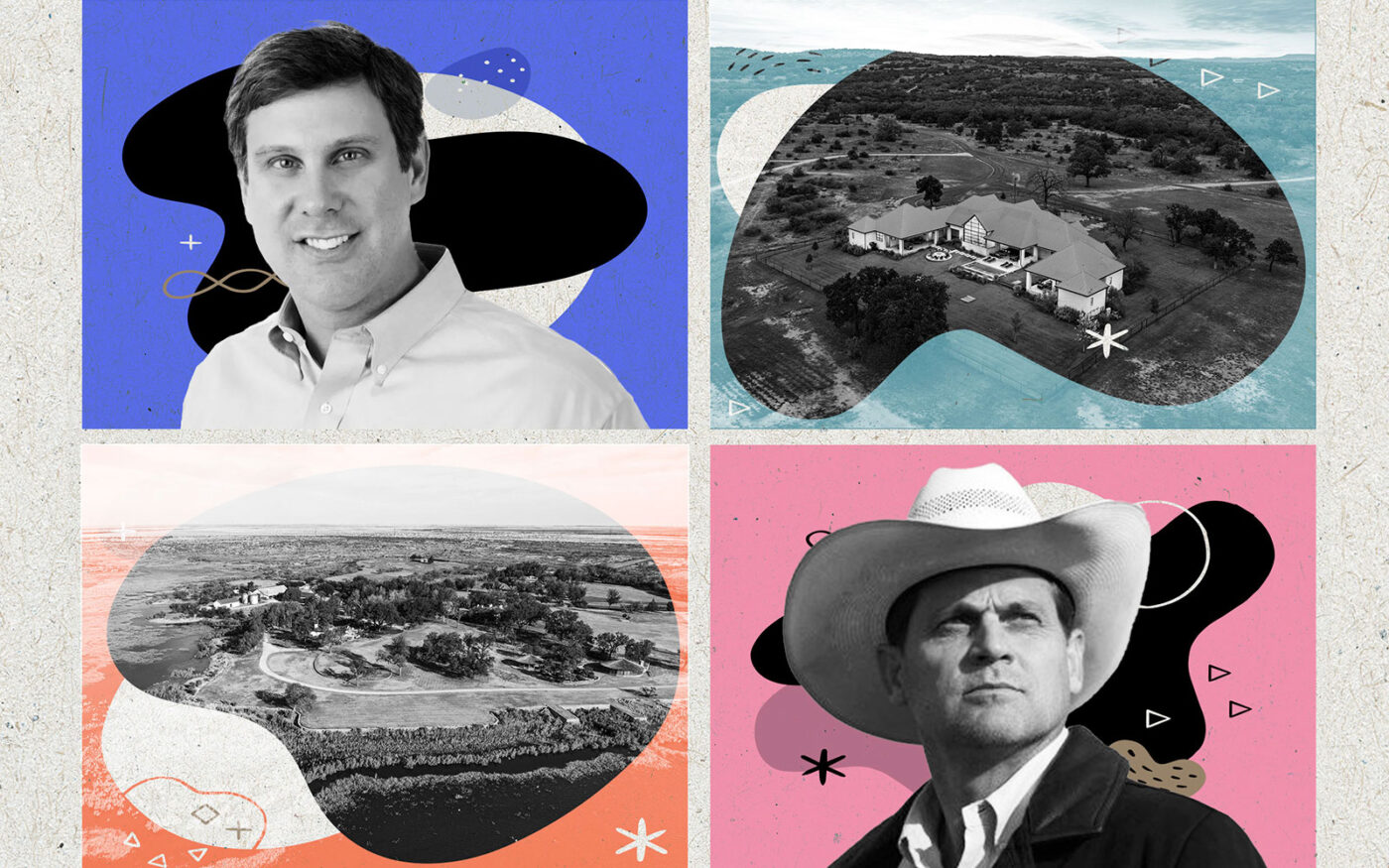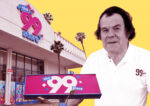The luxury ranch brokers fueling Texas’ land boom
Even amid a slowdown, luxury ranch brokers are minting new roughnecks

Randy Cadwallader buzzed open the gate to River Oak Ranch. Behind it lay a 5,200-square-foot mansion overlooking 1,560 acres of prime ranchland.
The place would go well with whiskey. Its rugged beauty encapsulates everything there is to love about the Texas Hill Country, a unique area just west of Austin where otherworldly trees grow stunted and twisted from the chalky limestone bedrock.
The house would fit in on the finest cul-de-sac, but nobody wants neighbors on their $37.5 million luxury ranch.
Cadwallader is now an agent with Dullnig Ranches, but he comes from a South Texas family ranch in Dilley that dates back to the late 1800s. After growing up in San Antonio, he moved to South Africa, where he helped arrange safaris and hunts. He came back to Texas but didn’t leave the wild behind, becoming a ranch broker. With his long, curly hair and wraparound shades, he looks the Southern outdoorsman. His favorite activities are hunting and golfing.
Though the state has some of the fastest-growing cities in the country, there is no high-end real estate more Texan than a luxury ranch. And the brokers selling those properties for tens, or even hundreds, of millions of dollars are not just playing in a fancy local market: They’re shepherding ranches into the future, as Texas’ urbanizing economy makes owning land more valuable — and more complicated — than ever before. Not every luxury ranch they sell stays a ranch. Some become tourist spots, while others become developments.
“There’s a mystique and an allure to ranching in Texas,” said Colton Harbert, an agent with Capitol Ranch Real Estate. “That’s something that I think is ingrained in all of us, even if we don’t realize it.”
Unsurprisingly, ranch sales exploded during the pandemic, as remote work and germophobia placed a premium on outdoor space. High interest rates have cooled activity on the low end of the market, but luxury ranches are still selling.
“A lot of these buyers are kind of immune to interest rates,” Harbert said. Now, with financial markets wracked by uncertainty, Texas ranch brokers are helping the richest buyers fulfill their “Yellowstone” dreams — or at least get some peace and quiet.
“People value being able to stand on top of the hill and look across to the next hill without looking at anybody else,” Harbert said.
Livestock and luxury
A ranch was once a working piece of land where livestock grazed, but in the last 20 years, it became another type of luxury real estate, on par with a lake house.
At River Oak, there is natural beauty, and there are also seriously high-end improvements. The main home has a marble waterfall countertop and herringbone hardwood floors. Outbuildings contain a barn-gym, space for vehicles and an enormous refrigerator for preserving game.
The current owner, who lives in Houston, shipped in whitetail deer from South Texas to build a trophy herd on the property. (Their supposedly superior genetics are a big selling point for River Oak.) Such a flex is not uncommon at luxury ranches, which often have a dude shed packed with ATVs and tricked-out Wranglers. Some owners import giraffes or gnus from Africa.
Cadwallader navigated his SUV through the ranch’s paved roads with an aerial map that showed the extent of its sprawl. Away from the house, there were no rooftops in sight. A family of turkeys waddled in the brush, each big enough for several Thanksgiving dinners.
“It’s not just cowboys and Indians anymore.”
High-end buyers don’t choose their ranches for the high-end houses on the hilltop, though. They have their own tastes and can build custom, Cadwallader knows.
“The things that sell are cool, historical improvements,” he said. “It’s the giant mansions that are tough sales.”
The property’s foreman, Cade, straight out of cowboy central casting with a worn canvas vest and a handshake that could bend steel, was working on a pipe by the hunting barn. Cade keeps the property in order while the owner is in the city.
Cadwallader drove all the way down to the Pedernales River, where the ranch has 1.3 miles of private frontage. A thin layer of ice glistened on top of the green-blue river. In better weather, it’s fair game for boating and fishing.
One can escape time and human intervention on River Oak Ranch. That could help explain another draw of ranchland at a time of financial turmoil: Many consider land a hedge against inflation.
As Cadwallader sees it, there are far worse ways to park your money.
“You can’t ride around and hunt on a Treasury bill,” he said.
“Cowboys and Indians”
Not all ranch agents are born-and-bred Texans. Through media savvy, hard work and charm, Australian Bernard Uechtritz has become the key face in the Texas ranch market.
Uechtritz spent most of his childhood in rural Papua New Guinea. As a 16-year-old, he managed a large plantation, and in his early 20s he moved to the U.S., eventually settling in Dallas. He publicizes this journey in his email signature: “Proud to be Australian, Privileged to live in America, Honored to call Texas Home.”
Deal flow has slowed for smaller properties. Many owners are locked in at low mortgage rates, and demand has settled for now.
“If you put a ranch on the market for $25 million, you better be damn sure it’s worth $25 million, because if you can’t justify that price, it’s just gonna sit now,” said Uechtritz, who, as founder of Icon Global, has sold some of the biggest ranches in the state.
But the higher end of the market is as active as ever. These properties, which Uechtritz simply calls the “big number” ranches, can cost more than $100 million and stretch thousands of acres.
“There’s still a lot of cash in that market,” Uechtritz said. “It’s a different category. [Interest rates] just haven’t impacted that market, and won’t.”
The enormous properties aren’t always kept as ranches.
As rural land prices have risen and urban populations have boomed, big number ranches make for promising development sites. Whether they’re used for master-planned communities or industrial developments, the state’s biggest ranches can often find fatter profits by ditching the cattle.
“You can’t ride around and hunt on a Treasury bill.”
Uechtritz’s firm recently listed South Creek Ranch, a 5,400-acre property 20 miles south of Dallas. Uechtritz thinks it can fetch $100 million or more, not for its ranching value but for its potential as an industrial hub.
The transition is not always easy, especially on legacy ranches.
“It’s tough for some of these families,” said Robert Dullnig, who owns the brokerage that employs Cadwallader. “They grew up on these places.”
But the money is there, and not just from the ultrawealthy. Institutional funds now snap up ranches too, and brokers see the opportunity: Icon is marketing Turkey Track Ranch, an 80,000-acre property in the Texas panhandle with 20 producing oil and gas wells. The ranch, which is asking $180 million, comes with 25 percent of the mineral rights, as well as wind, solar and water rights. It could also be developed for carbon sequestration.
Uechtritz has been helping buyers identify other means of turning a profit on their land.
One of the biggest sales of his career was Waggoner Ranch, which covers more than 510,000 acres across six counties in North Texas. Billionaire Stan Kroenke purchased it for $725 million.
In one attempt to boost the value of the ranch, Kroenke imported neither deer nor gnus.
Instead, he built a 367-megawatt wind farm on the land.
“It used to be a competition of who had the biggest pair of boots and the largest cow herd,” Uechtritz said. With this kind of money, “it’s not just cowboys and Indians anymore.”
Retail ranching
Two centuries ago, Richard King laid the groundwork for what could be considered the first luxury ranch, and the fate of his land holds a hint of the future.
King was not an extravagant man. Born in New York City in 1824 to Irish immigrants, he was indentured by his parents to a jeweler at age 9. Two years later, he stowed away on a ship, and by 26 he was a steamboat pilot whose company held a near monopoly over trade on the Rio Grande.
Soon after he arrived in South Texas, he began to pour his shipping riches into Texas ranchland. By his death in 1885, his holdings spanned 614,000 acres. As big as his ranch was, King built a home on the land so small that his wife had to keep her kitchenware outside.
King’s son-in-law, Richard Kleberg, had different plans. After King’s death, Kleberg built a mansion on the ranch called the Big House. It had Tiffany windows and a dining room that sat 50 people. The living room wall had murals of the Alamo.
But it has never been easy to live off the land in Texas, particularly in the Hill Country, whose thin, rocky soil seems to reject life.
More buyers now favor recreational uses, like hunting and watersports. Luxury ranches blend that old-Texas mythology with the comfort one would expect in a multimillion-dollar home, even when sliced into smaller and smaller pieces.
The King Ranch is still huge, at 825,000 acres, and King descendants continue to raise and sell cattle. But the ranch has other consumer-facing income streams. Visitors can book hunting trips, chasing a flock of 70,000 whitetail deer, 2,000 javelina and 18,000 nilgai, a type of Asian antelope. Branded leather jackets ($499) and needlepoint trays ($99) sell at a trendy shop in Austin. Special-edition King Ranch Ford trucks cruise city streets as well as ranch roads across Texas.
The experience and gear evoke it all: the generations who bought the land and drove the cattle, the old American West. The ranch still means open air, natural beauty and self-sufficiency, even if the ranch house is a palace.




